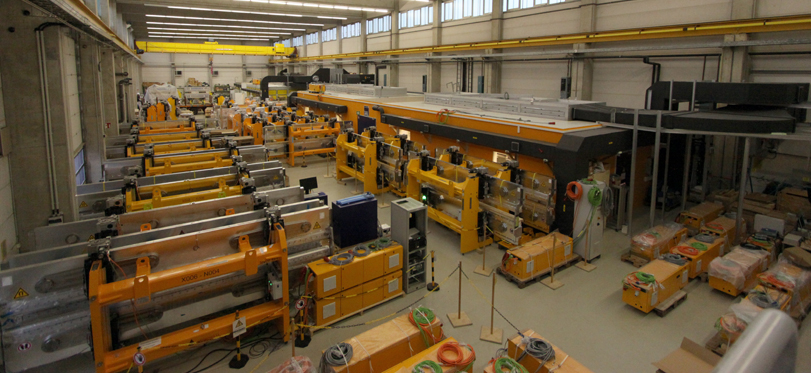More than half of European XFEL’s undulator segments ready for installation
52 tuned segments in storage awaiting beginning of installation next year
Out of the total 91 undulator segments, the group has fully tuned 52, which are now in storage and awaiting installation in the facility’s tunnels. Among the completed segments are the 35 needed for the first of three planned X-ray beamlines delivering flashes to the six scientific instruments.
Undulators are key components of the X-ray free-electron laser (FEL). Neodymium-iron-boron magnets generate the alternating magnetic fields needed for the self-amplified spontaneous emission (SASE) process to take place, generating the intense X-ray flashes.
“We closely cooperate with the European companies manufacturing the undulator segments”, says Georg Deron, the undulator group’s production manager. European XFEL scientists and engineers designed the undulator segments, and the undulator group is overseeing their production.

The undulators have to be finely tuned in order for the X-ray flashes to be generated reliably. After delivery of the assembled segments from external manufacturers to European XFEL, the most critical steps are done in-house at the undulator hall on the DESY campus. The undulator group makes precise magnetic measurements that inform the tuning of the undulator segments. Following strict specifications, they adjust the poles of each magnet with micrometre precision. They began tuning the segments in October 2012 and over time ramped up the pace of production to one undulator segment per week.
These undulators will be placed in three beamlines that lead to the instruments. The beamline which has all undulator segments ready, called SASE1, will produce the high energy “hard” X-ray FEL radiation needed for femtosecond time resolution experiments and studies of biomolecules, namely in the FXE and SPB instruments.
The undulator group has also been working on the undulator intersections, which contain moveable quadrupole magnets for focusing and steering the electron beam, beam position monitors, and other instruments.
“This is a complicated assembly of many parts from multi-national institutions from Spain, Russia, Switzerland, Sweden, and Germany”, says Joachim Pflüger, the undulator group leader. Many of these components are in-kind contributions from participating countries to the European XFEL.
Pflüger and Deron are confident that all of the undulator systems, including the intersections, will be ready for installation as scheduled by the end of 2014.